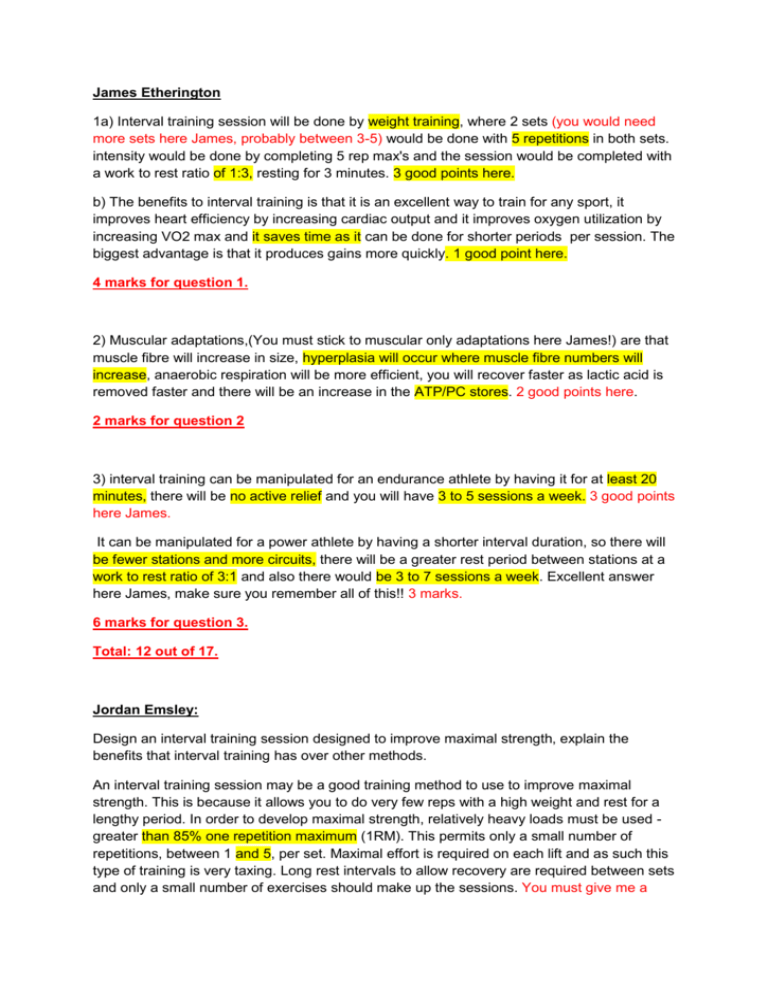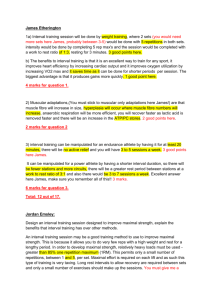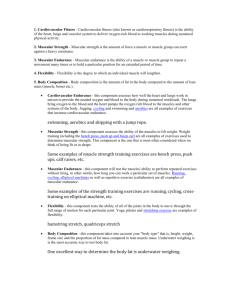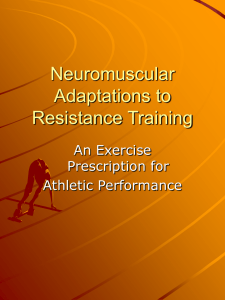Feedback_to_strength_questions_new
advertisement

James Etherington 1a) Interval training session will be done by weight training, where 2 sets (you would need more sets here James, probably between 3-5) would be done with 5 repetitions in both sets. intensity would be done by completing 5 rep max's and the session would be completed with a work to rest ratio of 1:3, resting for 3 minutes. 3 good points here. b) The benefits to interval training is that it is an excellent way to train for any sport, it improves heart efficiency by increasing cardiac output and it improves oxygen utilization by increasing VO2 max and it saves time as it can be done for shorter periods per session. The biggest advantage is that it produces gains more quickly. 1 good point here. 4 marks for question 1. 2) Muscular adaptations,(You must stick to muscular only adaptations here James!) are that muscle fibre will increase in size, hyperplasia will occur where muscle fibre numbers will increase, anaerobic respiration will be more efficient, you will recover faster as lactic acid is removed faster and there will be an increase in the ATP/PC stores. 2 good points here. 2 marks for question 2 3) interval training can be manipulated for an endurance athlete by having it for at least 20 minutes, there will be no active relief and you will have 3 to 5 sessions a week. 3 good points here James. It can be manipulated for a power athlete by having a shorter interval duration, so there will be fewer stations and more circuits, there will be a greater rest period between stations at a work to rest ratio of 3:1 and also there would be 3 to 7 sessions a week. Excellent answer here James, make sure you remember all of this!! 3 marks. 6 marks for question 3. Total: 12 out of 17. Jordan Emsley: Design an interval training session designed to improve maximal strength, explain the benefits that interval training has over other methods. An interval training session may be a good training method to use to improve maximal strength. This is because it allows you to do very few reps with a high weight and rest for a lengthy period. In order to develop maximal strength, relatively heavy loads must be used greater than 85% one repetition maximum (1RM). This permits only a small number of repetitions, between 1 and 5, per set. Maximal effort is required on each lift and as such this type of training is very taxing. Long rest intervals to allow recovery are required between sets and only a small number of exercises should make up the sessions. You must give me a work/rest ratio here Jordan like 1:3. To further aid recovery and allow maximal effort to be performed a vertical session design is preferable to a horizontal session design. In other words, one set of each exercise should be performed in sequence and repeated rather than completing all the sets for one exercise before moving on to the next. Even though the bar will move slowly during maximal lifts, the athlete must focus on lifting as explosively as possible in order to recruit the highest number of fast twitch motor units as quickly as possible. You make 2 good points here, but what about the advantages of interval training, you have missed this part out! 2 marks for question 1. Explain the muscular adaptations that occur after completing a weight training programme to improve elastic strength. What about even the first two simple adaptations of hypertrophy and hyperplasia of fast twitch muscle fibres? 0 marks for question 2. ?? Explain how circuit training can be manipulated to benefit the endurance and power athlete. During a circuit training session, exercises can be manipulated depending on whether an athlete wants to improve muscular endurance or power. If muscular endurance is what is being focused upon, sets and reps are going to differ from power. If muscular endurance is being trained, then a lower weight on a certain exercise such as bicep curls will be used. Also a high number of reps will be done to improve muscular endurance. To improve power this type of work out will be opposite. A very high weight will be used with very few reps. This is to push the working muscles to their maximum capacity which means they will fatigue very quickly. A lengthy rest is needed after each set when improving power so enough energy has recuperated so another set can be done. You must stick here Jordan again to what the question is actually asking you, not what you think it is asking. You have to stick to circuit training as the form of exercise. 1 mark for the longer rest period for power training. 1 mark for question 2. Total: 3 out of 17. Alex Etherington Design an interval training session designed to improve maximal strength explain the benefits that interval training has over methods (5 marks) Interval training is done overall for a period of 1 min 30 seconds for each ‘station’ that you have. To be able to improve your maximal strength you must work at around 70% plus of your maximum heart rate. The work:rest ratio should be 1:3. This will develop the performer’s anaerobic system and will also allow adaptations to occur to the body for improved maximal strength. Alex the question is asking about maximal strength training, so you must use weight training as your form of training and % of 1RM as your intensity guide. You score 1 mark for a correct work/rest ratio point. 1 mark for question 1 Explain the muscular adaptations that occur after completing a weight training programme to improve elastic strength (6 Marks) One of the first adaptations is cardiac hypertrophy, the question is muscular adaptations Alex! We are also training elastic strength, so any aerobic adaptations like cardiac hypertrophy would not be seen. which is the enlargement of the heart. Due to an enlargement of the heart this can cause an increase in stroke volume and venous return, which will in turn reduce the heart rate of the performer and reduce risks of getting hypertension. Also muscle hypertrophy can occur, when is the enlargement of muscle fibres. Hyperplasia can also occur, which is an increased number of muscle fibres. Systems will become more efficient, for example aerobic respiration will occur much more efficiently due to oxygen being pumped around the body and waste products being moved on quicker, for example lactic acid will be removed from the muscles quicker. Due to lactic acid being removed quicker this can delay on onset of OBLA. 2 good points made here. 2 marks for question 2. Explain how circuit training can be manipulated to benefit the endurance and the power athlete (6 Marks) Circuit training lasts for shorter periods of time than other methods of training. Although the rest periods that you have in-between exercises may be for longer as you work longer on each machine. Although the work ratio for circuit training is 1:1. Also circuit training should be done more frequently over the week, for example 3 to 5 times a week. 1 mark here Alex for the correct frequency, but you have failed to address how circuit training can be manipulated for the two different types of athlete. 1 mark for question 3. Total: 4 out of 17. Aidan Campbell: A type of interval training which is designed to improve maximal strength is weight training, the training should be designed 6 reps and 3 sets working at around 70% of max heart rate. It is not % of max HR Aidan, but a % of 1 RM. 3 good points made here. The benefits I interval training over others are interval training can develop both anaerobic and aerobic systems also interval training prevents boredom whilst training 2 good points here. 5 marks for question 1. After completing a weight training programme the muscle fibre should increase in size / muscle hypertrophy. Anaerobic respiration should become more efficient so from this there should become and increase in the tolerance of lactic acid which enables the athlete to work do longer periods of time 4 good points here Aidan, but you needed to make 6 points as this is a 6 mark question. What about increased ATP stores and efficiency of this system along with increased enzyme activity? 4 marks for question 2. Circuit training can benefit endurance and power athletes Endurance benefits • Because the intervals are longer than types of training and are from 3-5 mins to around 20 mins • The intensity of the intervals are rather low and have less emphasis of speed training (50-75% mhr) • More stations but fewer circuits 3 good points here Aidan around the endurance athlete, but what about the power athlete? 3 marks for question 3. Total 12 out of 17. Scott Johnson: 1) Describe an interval training session designed to improve maximum strength, explain benefits interval training has over other methods (5 marks) Maximum strength is the greatest force that is possible in a single maximum muscle contraction. Normally an athlete would use weight training for maximum strength. However using interval training the athlete could use a method called High-intensity interval training, this is an enhanced form of interval training, an exercise strategy alternating periods of short intense anaerobic exercise with less-intense recovery periods. Therefore the training session would involve the athlete working at a very high intensity of short anaerobic exercise with longer recovery periods, for example if the athletes one rep max on a bench press was 70KG, he would maybe do 3 reps at 65KG and then have a recovery period of at least 5 minutes (Work/rest ratio?) before he completes another set. You make 3 good points here Scott regarding type, sets and reps for your training. However you have missed out benefits of interval training like adds variety, gives quicker adaptations etc. 3 marks for question 1 2) Explain the muscular adaptations that occur after completing a weight training programme to improve elastic strength (6 marks) Elastic Strength is the ability to overcome resistance with high speed of contraction. After completing a weight training programme one muscular adaptation that can occur is muscular hypertrophy, an enlargement of the muscle fibre. When the muscle is stressed, the protective outside covering of the individual muscle fibres gets stretched, this stretching creates spaces where various materials, such as nutrients, can flow in and out. Weight training also increases protein synthesis, the increase in protein synthesis creates larger muscle fibres. Hyperplasia can also occur which is the splitting of muscle fibres to make more muscle fibres. All this increase in muscle fibres means that the muscles become more elastic so can contract at a greater speed and force. 2 good points here Scott but others you could have has include increased ATP-PC stores, increased buffering capacity and removal of lactic acid along with delay of OBLA. 2 marks for question 2. 3) Explain how circuit training can be manipulated (adapted) to benefit the endurance and power athlete (6 marks) Circuit training is a combination of high-intensity aerobics and resistance training designed to be easy to follow and target fat loss, muscle building and heart fitness. So it can be adapted to benefit an endurance and power athlete by involving high intensity short duration explosive exercises followed by lower intensity longer duration endurance exercises simultaneously, for example the athlete could perform a bench press of their one rep max followed by the most amount of push ups they can complete until exhaustion and then followed by another one rep max of a different exercise followed by another endurance exercise ect For here Scott you would need to talk about FITT principle and how it applies to circuit training. For instance how long does the session last, what is the intensity of work, how often do we train and what is the work/rest ratio. You have to do this for both the endurance and power athlete. 0 marks for question 3. Total: 5 marks out of 17. Ben Newby: The type of training which would take place for Maximal strength would be Weight training. This would involve taking out 6-8 repetitions of 3 sets, therefore making this training interval training as there are rest periods between each set. The ratio of work to rest will be around 1:3, the rest period being 3x longer than the work period i.e. the time taken to complete 8 reps. This work to rest ratio allows the performer to recover for the next set. In order to improve maximal strength the weight lifted will be around 70-80% of the performers maximum 1RM. The benefits which interval training has over other training methods is that it prevents boredom as it is not continuous and tedious, while another one is that it improves both aerobic and anaerobic systems. Excellent answer Ben covering 5 good points. 5 marks for question 1. The muscular adaptations which occur after completing a weight training programme in order to improve elastic are that the size of the muscular fibres will increase and therefore become more elastic and contract quicker with more force. The total number of the fibres will also increase, this is known as hyperplasia. This therefore would increase the type 2b fibres in the muscles to allow performer to become stronger. Other adaptations are the increased stores of ATP and PC as the increase in muscle cells result in an increase in body fuel stored within the cells. The enhanced buffering capacity results in the increased removal of lactic acid in the working muscles of the performer and therefore delays OBLA allowing the performer to work for longer without tiring. Again excellent answer. 6 marks for question 2. Circuit training can be manipulated to improve two types of strength. For the endurance athlete the circuit training will be of a longer duration between 3-5 minutes with the circuit lasting at least 20-30 minutes. Where as an athlete training power the duration will be shorter; between 0-90 seconds. The endurance athlete circuit will consist of more stations and lower circuits whereas the power athlete’s circuit will contain less stations directly related to improving power with more circuits. The work rate of the endurance athlete will be around 60-70% whereas the power athlete will be working between 80-90% due to the power athletes circuit being of a higher intensity. Great answer comparing the two athletes very well. 6 marks for question 3. Total 17 marks out of 17.










